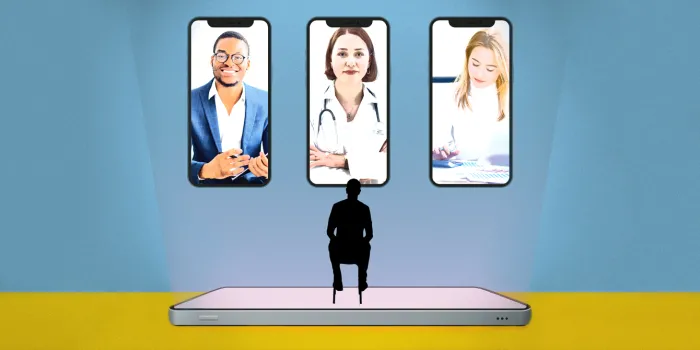Remote work, remote learning, remote meetups with friends — Americans have gotten much more comfortable conducting critical (and noncritical) tasks virtually since the start of the COVID-19 pandemic. And that includes medical care.
“During the first lockdown in 2020, the only way you could get care, unless you were very sick, was by telemedicine,” says Joseph Kvedar, M.D., immediate past chair of the board of the American Telemedicine Association. “And so there was a huge increase in utilization in just a few months.”
Telemedicine, also known as telehealth or virtual visits, can be a convenient way to make up a missed annual exam or streamline checkups for people in the blood and bleeding disorders community.
And use among the bleeding disorders community has been higher than national averages: More than a third of people with bleeding disorders accessed health care via telemedicine in 2020, according to that year’s National Hemophilia Treatment Center Patient Satisfaction Survey, compared with a quarter of Americans in general.
Telemedicine Advancements
Before the pandemic, most telemedicine visits — in which health care services are provided remotely via telecommunications — took place from a provider’s office or hospital room to connect with another provider, such as a specialist, who was not on-site. With the proliferation of mobile devices, telemedicine visits between a patient and a single provider became more common. But it wasn’t until the pandemic that virtual visits really took off.
In response to the sudden, massive need for virtual health care, the federal CARES Act earmarked $200 million to establish the COVID-19 Telehealth Program. The program was designed to get more providers to offer telemedicine visits so people could stay home while still getting the care they needed.
The policies also temporarily loosened regulations. Providers could now conduct telemedicine visits with patients regardless of their geography, be reimbursed for telemedicine visits at the same rate as office visits, and use popular videoconferencing platforms without violating privacy laws.
These regulatory changes are set to expire soon after the COVID-19 public health emergency declaration ends, so it’s possible this great progress in telemedicine could be erased in the near future.
“We really don’t know what will happen yet,” Kvedar says, “but we certainly hope we don’t lose any ground, given how useful telemedicine has proved to be.”
Virtually Endless Benefits
Although many people were introduced to telemedicine as a means to maintain physical distancing and avoid the spread of COVID-19, patients and providers benefit in numerous other ways.
Telemedicine makes specialized treatment accessible. There are 149 hemophilia treatment centers (HTCs) in the U.S., but many people still have to travel great distances to reach one. Roshni Kulkarni, M.D., a pediatric hematologist/oncologist at Michigan State University’s Center for Bleeding and Clotting Disorders in Lansing, Michigan, treats patients around the state, some of whom drive eight hours for visits. But it’s not just people in remote areas who benefit from telemedicine.
“Patients in urban areas, such as New York, have similar challenges,” Kulkarni says. “Your HTC may be just across town, but it might take you an hour or more to get there, depending on time of day. That’s a lot of missed work.”
Telemedicine is cost-efficient. “Certainly, when we saw the price of gas going up this summer, that was a burden for people having to travel to an HTC,” says Michelle Witkop, a nurse practitioner and the vice president of research strategy at the National Hemophilia Foundation.
Telemedicine saves people from unnecessary visits to the ER. When evaluating a laceration or hematoma virtually, a provider can get a good sense of whether the situation requires emergency care or can be treated at home with clotting factor. “Previously, we had to rely on a patient’s description or a photograph to determine if a bleed was an emergency,” Kulkarni says. “Now you can see them live. You can say, ‘OK, move your wrist’ or ‘Let me see how you walk.’ To me, that’s the biggest advantage of telemedicine.”
Telemedicine allows for more comprehensive care. Patients and providers can easily connect with specialists across the country and get second opinions when necessary. Also, “if a patient is in their primary care provider’s office having a telehealth visit with the HTC specialist, that makes the primary care provider part of that team,” Witkop says. “That allows them to understand better what’s involved in hemophilia care and gives them a connection with the HTC.”
Telemedicine in Perspective
For all of its upsides, telemedicine does have some drawbacks, chief among them being the lack of personal connection.
“You just have more well-rounded visits in person,” Witkop says. “You really get more of a sense of a person’s well-being when you’re face-to-face.” In-person visits also give providers the opportunity to palpate (feel) the abdomen and joints to check for inflammation and other abnormalities.
As such, telemedicine should not replace in-person visits, particularly with comprehensive follow-ups, when patients meet with their entire bleeding disorders team, including their physician, nurse, physical therapist, and dietitian.
“Telemedicine should be viewed as complementary, not as a replacement for in-person care,” Witkop adds. “Patients should be seen in person at least every year or year and a half, depending on what their HTC recommends.”

